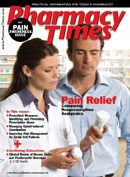Publication
Article
Pharmacy Times
Coagulation Counseling
Author(s):
Dr. Garrett is manager, Outpatient Clinical Pharmacy Programs, at Mission Hospitals in Asheville, North Carolina.
Clopidogrel May Be Harmful in Patients with Diabetic Nephropathy
No prospective randomized trials have examined specifically the long-term outcomes of clopidogrel use in patients with chronic kidney disease. A recently published post hoc analysis of the CHARISMA (Clopidogrel for High Atherothrombotic Risk and Ischemic Stabilization, Management, and Avoidance) trial examined this issue. The

CHARISMA trial randomly assigned patients without active acute coronary syndrome, but with established atherosclerotic disease (symptomatic) or multiple risk factors for atherosclerotic disease (asymptomatic), to clopidogrel plus aspirin or placebo plus aspirin. All CHARISMA patients (n = 15,603) were separated into 3 groups: nondiabetic patients, diabetic patients without nephropathy, and diabetic patients with nephropathy. Outcomes of patients randomly assigned to clopidogrel were compared with those of patients randomly assigned to placebo.
Patients with nephropathy who received clopidogrel had no difference in bleeding, but experienced significantly increased cardiovascular (CV) and overall mortality compared with those assigned to placebo. No differences were reported in bleeding, overall mortality, or CV mortality for nondiabetic or diabetic patients without nephropathy who received clopidogrel versus placebo. The asymptomatic group had similar results. Additional study is needed to fully investigate this finding.
Weight at Age 20 May Affect Risk of Developing Atrial Fibrillation

A recent Swedish study of 6900 men suggests that body surface area (BSA) at age 20 may correlate with the risk of developing atrial fibrillation (AF) later in life. Men in the study were followed for a maximum of 34.3 years. AF developed in 1253 (18.2%).
Larger BSA, which reflects weight and height, at age 20 correlated strongly with subsequent risk of AF. Body mass index (BMI) at midlife and weight gain from age 20 to midlife also correlated strongly. Patients had a greater than 2-fold increased risk of development of AF with increased BMI. These data were generated in a time and place where obesity was much less common than is currently the case in the United States. Because of the recent increase in the level of obesity, it is likely that the incidence of AF will continue to increase well above the 18.2% incidence as reported in this trial.
These findings are similar to the results of earlier studies that found an increased risk of AF in patients with a BMI >27. No definitive data on whether weight loss affects the risk of recurrence are currently available.
Aspirin Recommendations Focus on Age New recommendations for aspirin use for primary prevention of heart attack or stroke focus more on age than risk factors. Previous recommendations suggested aspirin for patients with a cardiovascular risk of at least 6% over a 10-year period. The new recommendations suggest low-dose (81-mg) aspirin for women aged 55 to 79 years and men aged 45 to 79. In patients >79, aspirin should be used only if the patient has no other bleeding risk factors. The primary benefit of aspirin use for men is heart attack prevention, whereas in women, it is prevention of ischemic stroke. Patients are more likely to benefit if they have additional risk factors such as smoking or hypertension. Patients with risk factors for bleeding (eg, chronic use of nonsteroidal anti-inflammatory drugs, previous gastrointestinal bleed) may need to avoid aspirin.
Combining Leg Compression with Anticoagulants Helps Prevent VTE
Compared with single modalities, combined prophylactic strategies significantly decrease the incidence of venous thromboembolism (VTE) in high-risk patients. The Cochrane Primary Care Group reviewed the literature comparing drug prophylaxis alone with combination therapy (pneumatic compression plus anticoagulants). The combination significantly reduced the incidence of deep vein thrombosis, but the effect on pulmonary embolism could not be determined because of the lack of events in the included studies. Anticoagulants used in the trials included aspirin, warfarin, unfractionated heparin, low-molecular- weight heparin, and fondaparinux. Most of the patients in the reviewed studies had either a high-risk procedure or condition. The surgical procedures were orthopedic, urologic, cardiothoracic, gynecologic, or general surgical. The magnitude of the reduction in VTE may be less for patients at lower risk.







